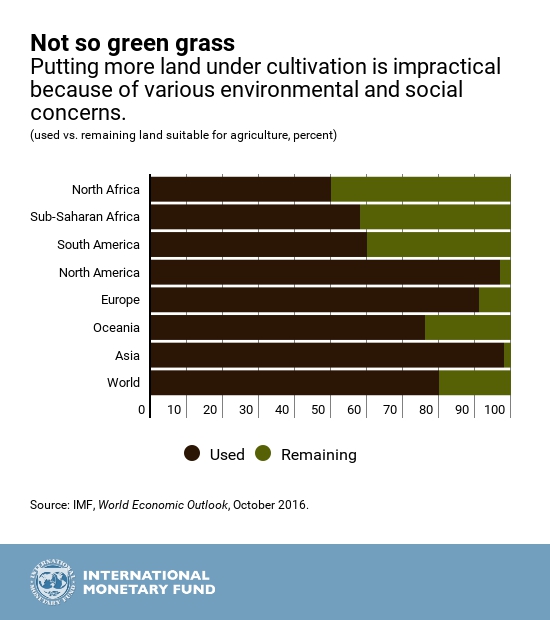Agriculture and food markets are plagued with inefficiencies that have dramatic consequences for the welfare of the world’s most vulnerable populations. Globally, farm subsidies amount to over $560 billion a year—equivalent to nearly four times the aid given to developing countries by richer ones. Major emerging-market nations have increased subsidies rapidly, even as rich nations cut theirs drastically. Meanwhile, tariffs on farm products remain a major point of contention in global trade talks.
One third of global food production goes to waste, while food insecurity is still rampant in developing countries. Even with the explosion of agricultural productivity since the middle of the 20th century, food security remains a challenge for much of the developing world. Food-calorie production will have to expand by 70 percent by 2050 to keep up with a global population that’s forecast to grow to 9.7 billion from last year’s 7.3 billion. Food insecurity can lead to violence and conflicts that can spill over well beyond borders.
How can policymakers meet the challenge? Removing market distortions, while not the whole answer, would go a long way in reducing food insecurity in developing nations. First, all countries must make a concerted effort to dismantle direct and indirect barriers to trade, which will help low-income nations develop their agricultural sectors. At the same time, low-income countries must also take action to raise productivity by removing obstacles to investment, thereby attracting much-needed foreign capital.

Land, productivity, and potential
Putting all of the world’s unused land into service, assuming everything else remains unchanged, would only suffice to feed 9 billion people. Of course, this rough calculation doesn’t account for advances in technology or reductions in food waste and land degradation, but it does illustrate the dimensions of the problem.
The answer, then, is improved productivity. There’s plenty of scope to increase output on existing agricultural land: in sub-Saharan Africa, for example, yields are currently 50 percent below potential. Yet barriers to cross-border investment make it harder to finance the adoption of new technologies that could boost yields. These barriers include inadequate infrastructure, risks of expropriation, and questions of land tenure or more generally opaque property rights. A surge in cross-border land deals in developing countries following the food crisis of 2007‒08 has since abated, raising questions about the sustainability of such investments.
As a result, while demand for food has shifted from West to East as a result of a different pace of population growth, advanced economies still account for the lion’s share of exports.
Challenges ahead
Rapid urbanization and galloping population growth, especially in Asia and sub-Saharan Africa, haven’t been matched by increases in domestic food supplies, leading to growing dependence on imports. Since 1990, 27 nations have switched from being net exporters of food to being net importers, including Honduras, the Philippines, Zimbabwe, and Vietnam.
Food has long been a sticking point in international trade talks, even though it makes up just 8 percent of the value of global commerce. Disagreements over agriculture torpedoed the Doha Round of global trade talks in 2008, for example. All countries continue to have a strong antitrade bias in the structure of aid to their farmers, wielding policy instruments—such as tariffs and quotas—that have serious consequences for consumers. Especially distorted markets include those for soybeans, sugar, rice, wheat, and beef.
Removing barriers would help link low income countries to global trade. Paradoxically, policies aimed at stabilizing prices and availability of food can have the opposite effect. In 2008, for example, rapidly rising prices prompted exporters to impose restrictions on overseas shipments of food in a bid to increase domestic supplies. Meanwhile, food importers lowered barriers to purchases from abroad. Taken together, these two policies exacerbated the food-price spike.
There are more effective ways to reduce price volatility in low-income countries, where food accounts more than half of total consumption. Food-price spikes can be damped by measures that include ensuring higher agricultural productivity, improved supply chains, and regional coordination to maintain and manage grain reserves.
Climate change poses yet another challenge to food security. In some regions, changes in average temperatures and patterns of precipitation, along with extreme weather events such as heat waves, reduce crop yields and livestock productivity. In other regions, moderate average temperature increases could instead raise yields. Less-developed countries closer to the equator are the most vulnerable. Ethiopia, where the two main rainy seasons supply more than 80 percent of its agricultural yields, recently experienced some of the worst droughts in decades.
Such extreme weather events are expected to worsen and increase in frequency. Measures such as “climate-smart’’ agriculture can ease the impact of climate change by offering smallholders opportunities to produce more nutritious crops in a sustainable and efficient way. Still, the challenges posed by climate change will only increase pressure on policymakers to dismantle the barriers to trade and investment that are restraining productivity gains in agriculture.
Read our commodities special feature in Chapter 1 of our October 2016 World Economic Outlook for more details on this issue. See also Picture This in the latest issue of Finance & Development.




